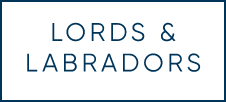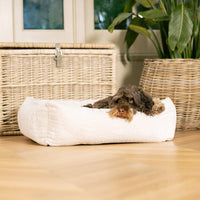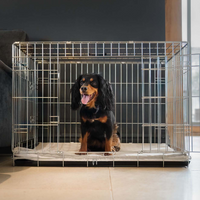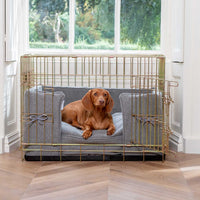Whenever you take your dog on a walk, you will want to ensure that your furry friend isn’t unhappy, in pain or able to escape and run away. For many dogs, a simple collar and lead will tick all of these boxes. But there are breeds that would be more suited to a harness than a collar. For example, a harness may be suitable for dogs that require extra support on the back such as Dachshunds or short-nosed dogs like Pugs and French Bulldogs. Equally, harnesses offer more control over particularly lively dogs or puppies and can be ‘kinder’ instead of constantly pulling on the neck.
However, in order for a harness to fit correctly, you need to properly measure to get the size exactly right. In this blog, we offer tips and advice on how to measure your dog for a harness before explaining how you would generally put the harness on your dog and help with adjusting the fit if it’s too loose or too tight.
How do you measure a dog for a harness?
Regardless of size or breed, all dogs need to be measured in the same way. However, fortunately, measuring your dog is a simple process and the measurements should be universal when it comes to identifying the correct size and style.
Harness sizing is often determined by the circumference of the dog’s neck and chest. As such, these are the measurements you will need.
How to measure dog chest size for a harness
To measure your dog’s chest size for a harness, all you need is measuring tape and a pen and paper to note down the measurement. Start by wrapping the measuring tape directly behind your dog’s front legs, comfortably connecting the tape together at the back. You should then make a clear recording of the measurement in centimetres.
Sizing for dog harnesses based on chest circumference:
| Extra Small | Between 30 and 44cm |
| Small | Between 44 and 56cm |
| Medium | Between 56 and 71cm |
| Large | Between 71 and 86 cm |
| Extra Large | Between 86 and 112cm |
How To Measure A Dog's Neck For A Harness
A neck measurement isn’t always necessary when picking a harness, but as it could decide the size of your dog’s harness, it would be advisable to make a note of it too. Simply wrap the measuring tape where the base of their neck and chest meet and record this measurement.
If, for some reason, the harness you’re considering for your dog is based on the circumference of their neck, the sizing will be calculated in a different way.
Sizing for dog harnesses based on neck circumference:
| Extra Small | Between 23 and 33 centimetres |
| Small |
Between 33 and 50 centimetres
|
| Medium |
Between 50 and 63 centimetres
|
| Large |
Between 63 and 76 centimetres
|
| Extra Large | Between 76 and 89 centimetres |
How to fit a dog harness
Choosing a harness that is the correct size for your dog is important, but it’s equally important to ensure that it fits properly. In order to check that the harness is correctly fitted to your dog, you should make sure that it’s put on them correctly, adjusting it using the straps, clips or other fastening system accordingly.
How do you put a harness on a dog?
There are several different types of dog harness, each offering different benefits. However, while a certain type of dog harness can be more suitable depending on the size and breed of dog, they also require a different approach when it comes to putting them on your dog.
Below, we’ve outlined how to put different types of harness on your dog:
How To Put On A Back-Clip Harness:
- Gently pull your dog’s head through the hole in the harness
- Ensure that the clip is positioned in the centre of their back
- Fit all clips together and attach your lead to the clip on the back
How To Put On A Front-Clip Harness:
- Carefully slip your dog’s head through the hole in the harness
- Adjust until the clip is positioned at the centre of their chest
- Connect all clips together and attach the lead to the clip in front of their chest
How To Put On A Step-In Harness:
- Unclip the harness, lay it on the floor and place your dog on top of it
- Fit your dog’s paws through the corresponding holes in the harness
- Pull the harness straps around the back of your dog and clip them together at the top
Can A Harness Hurt Your Dog?
If a harness isn’t correctly fitted or your dog pulls too much while wearing one, it could cause short or long-term health problems. For example, if a dog harness is too tight around the neck, it can put pressure on the throat and cause damage to the neck and spine, and if it’s too tight around the chest, it can cause an uncomfortable feeling of tightness around the ribs, potentially causing problems in the stomach. Additionally, a dog harness being too tight could also lead to skin irritation and chafing around the top of legs, neck and stomach, particularly on short haired dogs.
Due to this factor, it’s vital that you pick a harness that is the correct size, and if it needs to be altered slightly, adjust it accordingly.
How To Adjust A Dog Harness
Increasing or decreasing the tightness of your dog’s harness is something you should not only check when you try it on for the first time, but every time they use it. Whether it’s caused by a change in weight or natural growth, it’s to be expected that your dog may change size. Fortunately, however, dog harnesses offer simple methods of adjusting the size.
You should first read the instructions to understand ways in which it can be adjusted. For many dog harnesses, there are straps that can be altered to offer more or less room depending on the size of your dog.
How Tight Should A Dog Harness Be?
Determining the correct harness size for your dog can be difficult, and as a tight fit could cause harm and a loose fit could make it easier for them to escape from the harness, it’s something of a balancing act. However, there is a rule of thumb that many trust as a way of judging the correct fit for any dog harness.
Often also used for checking that a collar isn’t too tight or too loose on both dogs and cats, many people will use two fingers to indicate enough space between a dog and a harness. Once you’re happy with the fitting of your dog’s harness, put two fingers into each section, and if they fit comfortably, the sizing should be suitable and unlikely to cause any harm to your dog.

































































































